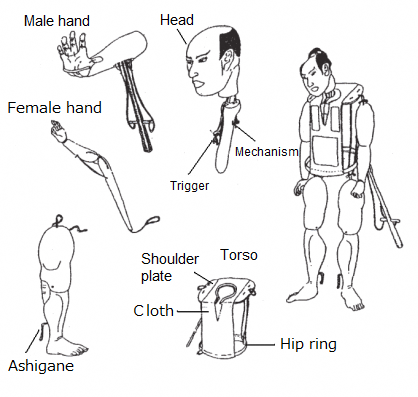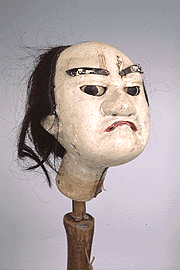Kuroda Puppet company [Kuroda Puppet visual data]
|
|
Bunshichi |
Bunshichi |
Bunshichi |
|---|---|---|---|
|
Bunshichi |
Kenbishi |
Yuusen |
Wakaotoko |
|
Adayaku |
Tsume |
Kintoki |
Shuuto |
|
Jiji |
Otokokoyaku |
Musume |
Musume |
|
Musume |
Musume |
Musume |
Ofuku |
|
Fukeoyama |
Baba |
Gabu |
Sanbaso |
Puppet’s structure and part’s names

Puppet’s structure (1)
- It is not made in one piece but it is made of a head, upper torso, hands and feet but only tied together by strings.
- For the female puppets without legs, the shape is shown by the fabric hem.
Puppet’s structure (2)
When looking at a puppet without costume, it comes to making only a Kashira(*1), shoulder plate, hip ring, hands and feets. The oval shaped shoulder plate brings out the thickness of the shoulder and chest and the rod passing through its center supports the head. The hip ring made of bamboo expresses the roundness of the hips while the fabric cloth connecting the shoulder plate to the hip ring creates the chest.
Hands are hung from both left and right hands of the shoulder plate with hemp strings. The legs are hung from the hip ring. The usual body called kirido is made of a cloth but a papier-mâché torso called marudo is also used in special cases. Female puppets do not have legs so a small futon is hung from the hip ring. This is called Bonbora, it is used to obtain the shape of knees while sitting. Male puppets have a little stick attached to their shoulder plate. This is called "ikitake"(breath bamboo), when the puppet takes a deep breath, the stick is used to push up the shoulder plate to express it.
*1 A Kashira is from the head to the neck of the puppet including its head movement mechanism.

























